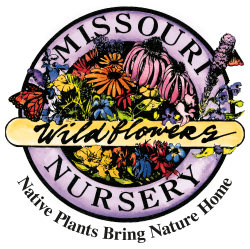Tips for Success
22nd Jun 2023
Start with plants, not seed. Plants yield almost instant results in mulched flower beds. It can take three years for a seeded planting to begin to look good. Seeds can be used to start plants in containers that will later be used in beds.
Think about design. Many gardeners today grow native plants to benefit wildlife, and we strongly encourage that. If wildlife benefit is the purpose, design could take a backseat in favor of added diversity and a more naturally structured appearance. A border around a flower bed will help define the bed and set it off from the lawn. Borders can be made of rocks, bricks, concrete pavers, or commercial edging products. Include contrasting foliage and flowers. Be sure to include native grasses and sedges. Use a variety of plants because, unlike annual bedding plants, perennials don't bloom all summer. Contrasting foliage, different blooming periods, and the constant changes from spring through winter make a wildflower garden an exciting place all year.
Mulch beds soon after planting, then as needed for control of weeds and for cosmetic value. Apply a fine-particle mulch after the plants are installed and the soil has been smoothed to get rid of any dirt clods. If short ground cover type plants are used between larger plants, the ground cover plants will become a green mulch and eliminate the need for later mulch applications. Yearly mulch applications should not result in more than two total inches of mulch at any time.
Amend the soil in shady flower beds. True forest-dwelling, shade-loving wildflowers prefer a 3- to 4-inch layer of rich, organic soil at the surface. If your shaded location doesn't have a rich organic layer of soil at the surface, add a 3- to 4-inch layer of composted organic material. If the shaded location is not under trees, it is okay to mix the organic material into the top 3 to 6 inches of existing soil, but if the site is under trees, tilling the soil will damage tree roots.
Amending soil in sunny flower beds isn't absolutely necessary. Most sun-loving wildflowers do great in good topsoil. Adding topsoil and/or organic material to beds where soil is poor will help. Plants that prefer very dry conditions and sun may become too large and flop over or stay too moist with the addition of organic material to the soil. Just tilling the soil 4 to 6 inches deep in preparation of a sunny wildflower bed will make plants grow better. The added soil oxygen improves root growth.
Fertilizer and lime? If you suspect the fertility or pH of your soil is not right, have a soil test done through your local University Extension Center. The Extension Center will have the information and materials to make the sampling easy. A soil test is the only way to determine if you need to adjust your soil's pH. Adding fertilizer when the garden is first planted will help the plants fill their allotted space quickly, bloom earlier, and out-compete weeds. There generally isn't a need for fertilizer after the first planting.
Watering native wildflower gardens: Water plants when you put them in the ground to settle the loose soil around the roots. During the first growing season after the initial planting, water only after determining that the soil is getting dry by inspecting the soil under the mulch. During subsequent growing seasons, water enough to meet the moisture requirements of the species being grown. Because it is a garden, you want the plants to keep growing, blooming, and looking good during dry periods. If they get too dry, they may go dormant.
Deadheading: Annuals and some perennials can be stimulated to bloom longer by pinching or cutting off the spent flowers. (We don't encourage deadheading if the goal is to feed birds and wildlife.) You can keep formal flower beds looking their best by removing any part of a plant that begins to decline after blooming. Perennial plants often respond to drastic pruning--to 3 or 4 inches high--by sending up new, shorter growth for the rest of the season.
Keep the weeds out. By keeping the soil covered with 1.5 to 2 inches of mulch, you will have very few weeds in a wildflower garden. Weeds multiply. Be vigilant and keep weeds from maturing and dropping their seeds into the garden. It is important to recognize perennial weeds, such as sericea lespedeza, tall goldenrod, and crown vetch. Over time, unwanted trees and shrubs may appear.
Encourage shade-loving wildflowers to reproduce. Seeds of shade-loving wildflowers will germinate in the spring if they are not covered by tree leaves. To increase wildflower seedling numbers, remove the tree leaves, break them into smaller pieces with a mower, or burn them by the end of February.
Clean beds annually. Cut the plants back to 1 or 2 inches high each year by the end of February. Birds will use the garden more if the plants are left standing until late February. Excessive dead vegetation and tree leaves can choke the growth of desired plants. An annual cleanup gives the bed a fresh new look in spring.
